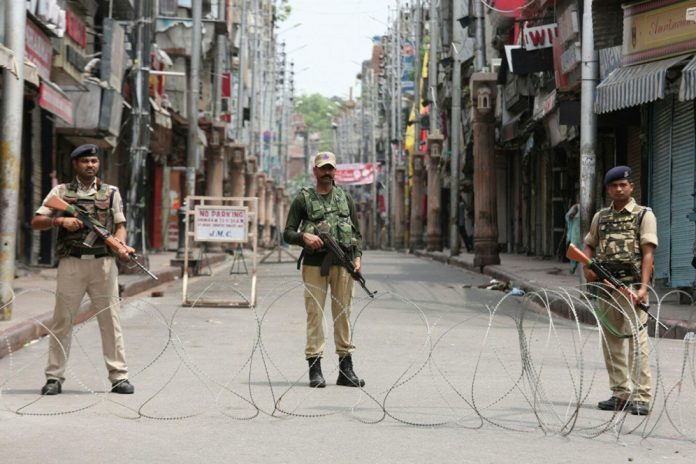From 1989 onwards militancy in Kashmir had passed through various phases. It acquired a qualitatively new terrorist character. Having permitted conditions within Kashmir to deteriorate to the level that they had reached, the Indian state had little option but to fight hard to break the insurgency. The Kashmir policy of the Government of India has been marked by the carrot and stick approach. It was then supplemented by lavish central aid to the state along with the supply of rice at heavily subsidised rates. More generous central aid was once again promised in exchange of Farooq’s agreement to share power with the Congress in 1986. From the start, force and aid had been used as instruments to win the loyalty of the people not for the nation but the government and party in power. Indian misrule gave birth to an uprising in Kashmir. In course of time militancy entered a new phase. It was no longer a fight-between the militants and the security forces. It gradually assumed the form of a total insurgency of the entire population. The conspicuous failure of the state had occurred earlier in allowing matters to get to that point.
Insurgency and nuclear explosions
In this atmosphere of total confrontation between security forces and the Kashmiri Muslims, the excesses of the militants and the killing of innocent civilians by them could hardly attract much attention. By the time Pakistan decided to start a low-intensity conflict in Kashmir based on the experience gained from the deniable war in Afghanistan it had pursued in the Eighties together with the US against the Soviet Union. General Zia had transformed Pakistan under his strategy of Islamisation. The very nature of the militant movement in Kashmir implied intolerance of dissent and use of violence as the principal means of action. Its targets were not always the personnel of the security forces and so-called informers but also civilian officials and non-officials, political leaders and common citizens.
In 1998, the Kashmir dispute attained an extra dimension when India and Pakistan became overt nuclear powers. By the time Pakistan embarked on the Kargil operation in 1999, the low-intensity conflict in Kashmir was yielding mostly negative results for Pakistan in terms of international support. The operation clearly meant to highlight the Kashmir cause, failed to make Pakistan realise that it had become too isolated internationally for the policy of highlighting to work. Afterwards, offers and counteroffers were made for the settlement of Kashmir by both countries but they rejected for the reason best known to all. Just after the war Pakistan urged India to take up the Kashmir issue on “priority basis” as it was root cause of tension between the two neighbours. Meeting of leaders– Vajpayee and Nawaz Sharif in July 1998 at the SAARC Summit in Colombo had paved the way for the resumption of stalled dialogue between the two countries. They agreed, despite disagreements to move towards a solution which would be in the mutual interest.
Post-Pokhran relations
In the post-Pokharan and Kargil periods the problem of Kashmir has the potential to create not only armed confrontation but also possible nuclear war. That is why the rapprochement between India and Pakistan has been supported by overseas powers. The process of confidence–building measures initiated by India and Pakistan needs to be institutionalised and an element of irreversibility needs to be embedded in these measures. A solution could grow to become a resolution, if the mindset of the peoples in the region change. Once a framework had been created, which involved intensive dialogue between India and Pakistan it would not be difficult to find a solution. Pakistan has to be dealt with a multi-pronged strategy. Most importantly, we have to strengthen communal harmony and promote respect for pluralism within India. Pakistan will see the futility of seeing parity with India only when we are at peace domestically. Trade, contacts and economic affairs would be regulated by both sides, which would also be responsible for Kashmir’s external security. Domestic policy would be decided by an elected autonomous government. In contrast to the policy adopted in Punjab which led to the untold human sufferings, the ‘healing touch’ policy is on the card in Jammu and Kashmir. The root cause of the lack of a strategic vision in India’s policy is the inability of Indian Policymakers to look at themselves through Kashmiri eyes.
Role of Kashmir
The entire series of misunderstandings reveals how difficult it has become for governments to make radical departures of policy in the information age. The only way to bring lasting peace is to eschew find goals and concentrate on the process. Open road and rail links between the parts of Kashmir, open both parts of Kashmir for tourism and trade, give both parts of Kashmir the autonomy that their constitutions normally contain, allow them to form links with each other, and do all these in steps with the normalisation of relations between India and Pakistan. This can only be done in stages and trust will grow as each stage is completed.
India and Pakistan have a more than half century experience of the subject which they have seen through the Kaleisdoscope of war and terrorism, verbal duels in the United Nations, bilateral negotiations and quasi-mediation. At the end of the day it is becoming clearer to both sides that neither reference to historical claims nor the UN resolutions and liberation struggles will resolve the problem. The ‘final settlement’ the two sides are committed to can only come through a political compromise which must be fashioned with the understanding that politics is, after all, the art of the possible.
The views and opinions expressed in this article are those of the author and do not necessarily reflect the official policy or position of The Geopolitics.

Dr. Rajkumar Singh is a University Professor for the last 20 years and presently Head of the Postgraduate Department of Political Science, B.N.Mandal University, West Campus, P.G. Centre, Saharsa (Bihar), India. In addition to 17 books published so far there are over 250 articles to his credit out of which above 100 are from 30 foreign countries. His recent published books include Transformation of modern Pak Society-Foundation, Militarisation, Islamisation and Terrorism (Germany, 2017), and New Surroundings of Pak Nuclear Bomb (Mauritius, 2018). He is an authority on Indian Politics and its relations with foreign countries.


